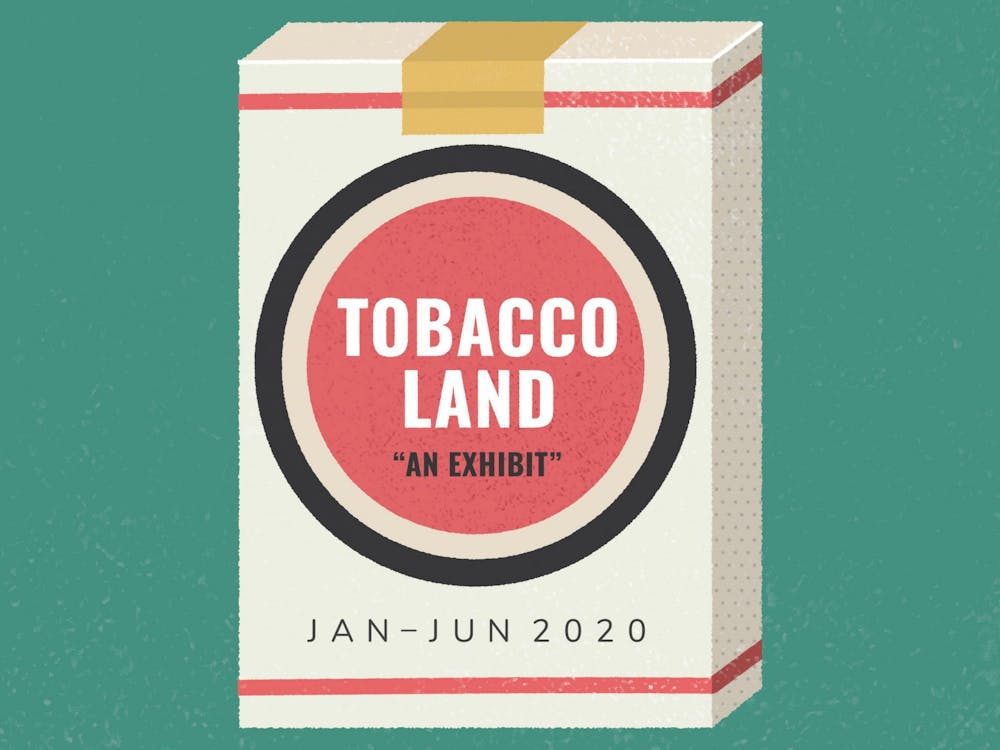This year, smoking policies are changing on both the federal and campus level. Not only are there now greater nationwide age restrictions when buying tobacco products, but Duke is launching a Smoke-Free Campus initiative this summer. Looking at the history of smoking, its advertisements and its relation to Duke’s campus can help us understand the impact and intentions of these changes.
“Tobaccoland” reveals the complexities of marketing both for and against the tobacco industry. The exhibit’s curators — Hartman Center Reference Archivist Joshua Larkin Rowley, Head of Technical Services Meghan Lyon and Assistant University Archivist Amy McDonald — created the exhibit using resources from the University Archives as well as books discussing the development of the tobacco industry. The photos, advertisements and artifacts of the exhibit show how Big Tobacco infiltrated both American media and life in Durham throughout the 20th century.
It is known that cigarette advertising was once ubiquitous in the nation, but students often forget that Duke was founded on tobacco money. This exhibit displays the inherent connection between the Duke family, Durham and tobacco. Several defining pieces of Durham, including the American Tobacco Campus and the city’s mascot (descending from Bull Durham smoking tobacco) are indicative of the city’s success in tobacco manufacturing.
“Duke University had a number of researchers, including Paul Gross [of Gross Hall], who were deeply involved in tobacco research,” McDonald said. “There were programs finding ways to farm tobacco in a more effective and economic way, but then there were also a lot of faculty members and students studying the composition of tobacco smoke and carcinogens, and that research was being fed to the different tobacco companies. Duke was connected to a lot of it.”
The university, however, was not consistent with its policies regarding smoking: Smoking was prohibited on campus in 1883, but by the 1920s, full-page ads for Old Gold cigarettes filled The Chronicle. The stigmas and rules regarding smoking have fluctuated throughout the university’s history, shifting as recently as this year’s move toward a smoke-free campus.
Although the dangers of smoking are widely accepted today, preventative measures were often disregarded throughout the 20th century. The widespread ignorance of smoking’s negative effects wasn’t due to a lack of science, but rather the overwhelming influence of the tobacco industry in the media.
The industry masterfully appealed to the salient demographics of a given era. Virginia Slims appealed to young working-class women by stating that women are “biologically superior to men,” L&M appealed to the Black Power movement by emphasizing African “roots to be proud of” and several companies attracted children with sugar sticks packaged as “candy cigarettes.”
“There have always been concerns over what the children are doing, concerns over appearances, who should be allowed to smoke and what is cool,” Lyon said. “All these different pieces seem cyclical, all the way back to the early marketing that the Dukes didn’t necessarily invent [smoking cigarettes], but certainly did popularize [it].”
And yet, as long as people have been smoking, people have been fighting against smoking. “Tobaccoland” demonstrates how the movement against smoking is nothing new; as early as 1868, there were publications demonizing smoking as a “physical, mental, moral and social evil.” Several books, posters and advertisements in the exhibit focused on the immorality of smoking to deter people from the habit. It wasn’t until the 1980s, however, that the health implications of smoking entered public awareness.
“I think the more that public health advocates made the connection between diseases stemming from cigarettes, the more people started to push back on smoking in public and smoking around children,” Lyon explained. “There’s been gradual public health campaigns that have gotten more funding based on litigation, but also general acceptance through the public.”
Such public health campaigns now look at the effects of e-cigarettes, such as the widely popular JUUL. “Tobaccoland” illustrates how the development of these “safer alternatives” has followed the development of traditional tobacco products; both were initially unpopular, both added flavors to increase popularity and both targeted the youth market with bright colors and advertisements on youth-based platforms. Unfortunately, the long-term effects of vaping have yet to be confirmed.
By showing the advertising methods and secrets of the tobacco industry, “Tobaccoland” allows students to become more aware of how corporations manipulate the public for their interests. The exhibit suggests that by learning about the media of past corporations, we can protect ourselves from their modern descendants.
“Tobaccoland” is located in the Mary Duke Biddle Room in the Rubenstein Library. It is on display until June 20.
Get The Chronicle straight to your inbox
Signup for our weekly newsletter. Cancel at any time.

